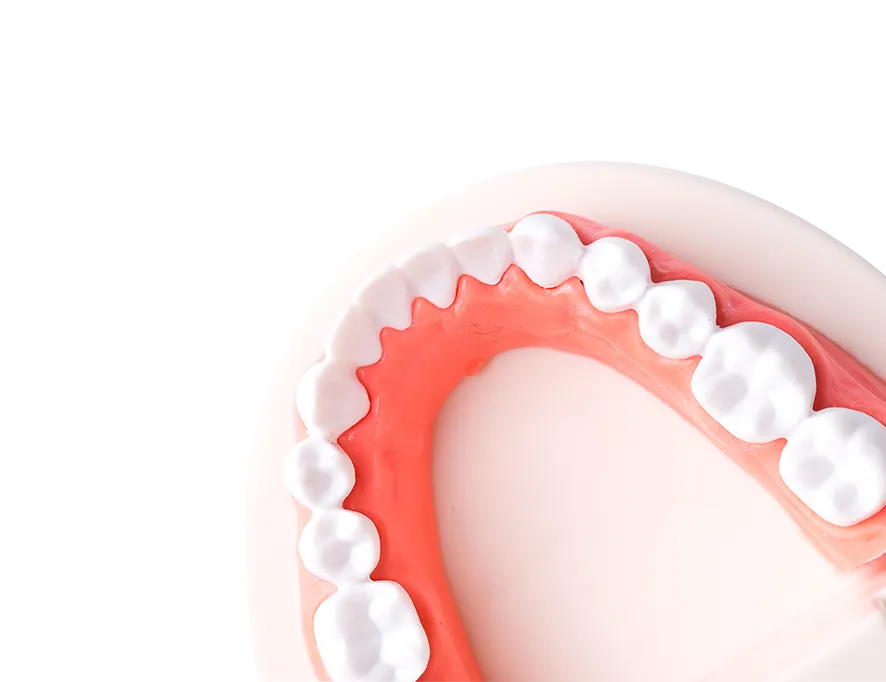Periodontology – an important branch of dentistry
Periodontology is a very important branch of dentistry. It deals with gingival disorders, such as gingivitis or periodontitis. More specifically, periodontology is specialized in diagnosing and treating diseases that affect the gingiva and supporting tissues of the tooth, always drawing attention on the importance of the proper dental hygiene.
A specialist in periodontology will detect the gum disease, the level of bone loss and recommend a proper treatment depending on the depth of the periodontal pockets and the complexity of the case.
In DENT ESTET clinics, specialists in periodontology use the newest generation equipment (Biolase diode laser, iPlus Waterlase laser, Florida probe) to stop the evolution of periodontal diseases, thus helping the patient to keep his natural teeth on the arch for as long as possible.
The causes of periodontal disease:
Many bacteria live in the oral cavity, that together with other substances and acids from the daily diet, create a sticky layer that deposits on the teeth and forms the bacterial plaque. This is why, the main cause of periodontal disease is poor dental hygiene that favours the accumulation of excess bacterial plaque on the teeth and in subgingival areas. To combat this bacterial layer that deposits on the teeth at any time of day, the body releases substances that lead to inflammation and redness of the gums. This is also the first signal that there is a problem that must be treated with the help of the dentist.
Therefore, the practice of proper dental hygiene at home every day, in the morning and especially in the evening, for a minimum of 2 minutes for each brushing and use of dental floss is the easiest way of keeping dental health.
However, by ordinary brushing we cannot remove the tartar, which is the part of the bacterial plaque that has hardened and remained on the teeth. The tartar can be cleaned from the teeth only through professional hygiene in the dentist's office, by scaling and professional brushing.
The visit to the dental office for the regular prophylaxis meeting is recommended to be made every 6 months.

The first signs of periodontal disease:
-
Persistent unpleasant breath
-
Red, inflamed or bleeding gums
-
Gingival recession
-
Pain while chewing food
-
Teeth sensitivity and mobility
-
Tooth loss
Types of periodontal disorders:
 Gingivitis
Gingivitis
În stadiul inițial al bolii parodontale sunt afectate doar gingiile. Gingivita poate fi identificată de către fiecare pacient prin inflamarea gingiilor, înroșirea acestora și sângerările frecvente la periaj sau chiar spontane. Osul nu este încă afectat. În acest stadiu nu avem pierdere osoasă.
Tratamentul local al gingivitei presupune realizarea profilaxiei profesionale în cabinet (detartraj, airflow, periaj profesional) însoțită de o igienă orală zilnică la domiciliu adecvată: utilizarea tehnicilor corecte de periaj, folosirea aței dentare și a periuței interdentare, utilizarea dușului bucal, folosirea apei de gură etc.
 Periodontitis
Periodontitis
If the gingivitis is not kept under control, the bacterial plaque overcomes the local defense system, leading to almost complete gingival retraction and the discovery of the root, increasing the mobility of the tooth and affecting the integrity of the bone.
In advanced cases of periodontal disease, local treatment is applied by sterilizing the periodontal pockets surgically or with the help of dental lasers, in order to avoid tooth loss.
To stabilize pacients affected by periodontal disease, there are many procedures that can be done: scaling and root planning, antibacterial substance application, local treatments for reduction of the periodontal pockets (classic and lasers procedures). In advanced stages, remanent periodontal pockets are treated surgically and by using guided regeneration therapy.
In order to ensure the success of the treatment for a periodontal disease the collaboration of the patient with the periodontal specialist is vital for obtaining lasting results.
How the diagnosis is established:
In order to establish the diagnosis and the stage of the periodontal disease, it is necessary to visit the specialist in periodontology. He will coordinate the case and ensure the accuracy of the diagnosis by:
• Examination of the soft tissues and marking of areas that are inflamed
• Paraclinical examinations like digital radiographs and CBCT
• Periodontal measurements using the latest digital technologies( Florida probe)
• The medical history of the patient, vicious habits (smoking) and information regarding the daily dental hygiene, evidence of long term medical treatments (if the patients is in medical evidence for any disease that requires special medication) etc.
• Performing specific investigations or blood tests necessary to complete the clinical panel
The American Academy of Periodontology recommends that all adult patients carry out a periodontal health assessment that includes:
• Complete examination of the teeth, gums and soft tissue
• The level of tartar
• Oclusion ( bite)
• Bone structure
How we treat the periodontal disorders:
The treatment of periodontitis implies, besides the rigorous and correct oral hygiene performed by the patient at home and the use of the latest technologies that offer the benefit of a rapid, efficient and local intervention, without affecting the integrity of the healthy tissues.












